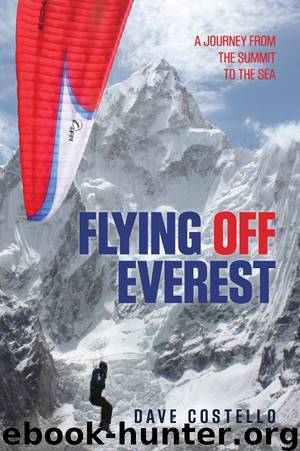Flying Off Everest by Dave Costello

Author:Dave Costello [COSTELLO, DAVE]
Language: eng
Format: epub
ISBN: 9781493009152
Publisher: Lyons Press
Lakpa and Babu’s current predicament was not an entirely new one. In 1862 two English scientists named Henry Coxwell and James Glaisher actually became the first people to fly above 29,000 feet without the aid of supplemental oxygen. It was not on purpose. And it did not go well. The pair took off at 1:00 p.m. on September 5 from Wolvering-hampton, England, in a wicker basket attached to a 90,000-cubic-foot hydrogen-filled balloon. Overhead, a solid cloud deck loomed (in hindsight, ominously). They were dressed in simple wool suits, befitting their scholarly professions and the chilly autumn day. Their plan: rise to an elevation of approximately 26,000 feet, recording temperature and humidity levels along the way, then climb up into the overhead rigging and pull the gas release line and descend. In spite of the fact that no one at the time actually knew how the human body would react to being at extreme altitude, Coxwell and Glaisher smartly anticipated the air expanding and thus thinning as they climbed, and guessed, quite rightly, that it might present them a problem once they were about 5 miles up. So they decided that’s when they would call it quits and descend.
Things started off well enough. The pair climbed steadily toward the clouds, beginning to handwrite their measurements at precisely 1:03 p.m. Coxwell would later write about the experience, saying, “On emerging from the cloud at seventeen minutes past one, we came into a flood of light, with a beautiful blue sky without a cloud above us, and a magnificent sea of cloud below, its surface being varied with endless hills, hillocks, mountain chains and many snow white masses rising from it.” He tried to take a picture, but the silver bromide crystals in the film he was using didn’t expose right. After nineteen minutes they reached an altitude of about 10,560 feet. The temperature, as they had predicted, was dropping—a lot faster than expected. The two mildly overweight forty-three-year-olds also noted having a newfound shortness of breath. Hypoxia, which is what they were suffering from, wasn’t a concept fully understood in the Victorian era. At just over 21,000 feet, they began having trouble writing down their measurements. Their hands, they also noted, were freezing.
After forty-seven minutes Coxwell and Glaisher reached their planned maximum altitude, just under 29,000 feet. The temperature was -30 degrees Fahrenheit. Frostbite was setting in on every part of their bodies that was exposed to the air. They were gasping for breath and feeling precariously light-headed. They realized, suddenly, that they could no longer even read their instruments. Glaisher noted that he didn’t seem to have any control over his arms and legs, shortly before passing out.
It was at this moment, after seeing his cohort slip unexpectedly into unconsciousness, that Coxwell decided it would be prudent of him to begin their descent. Without the use of his now-frozen hands, Coxwell somehow clambered his way up the rope rigging supporting their wicker basket, grabbed the gas release line between his teeth, and pulled three times.
Download
This site does not store any files on its server. We only index and link to content provided by other sites. Please contact the content providers to delete copyright contents if any and email us, we'll remove relevant links or contents immediately.
| Excursion Guides | Mountain Climbing |
| Rock Climbing |
Annapurna by Maurice Herzog(2839)
Into Thin Air by Jon Krakauer(2701)
SAS Survival Handbook by John 'Lofty' Wiseman(2260)
The Ogre by Doug Scott(2114)
Reservoir 13 by Jon McGregor(1852)
Everest the Cruel Way by Joe Tasker(1827)
The End of Eddy by Édouard Louis(1746)
Touching the Void by Joe Simpson(1706)
The Push by Tommy Caldwell(1685)
Iced In by Chris Turney(1579)
The Call of Everest by Conrad Anker(1550)
The Isle of Mull by Terry Marsh(1517)
Miracle in the Andes by Nando Parrado(1494)
Touching the Void (1987) by Joe Simpson(1413)
Mud, Sweat, and Tears by Bear Grylls(1300)
Himalaya Bound by Michael Benanav(1256)
Higher Calling by Max Leonard(1241)
Death Grip by Matt Samet(1160)
Backcountry Bear Basics by Dave Smith(1128)
